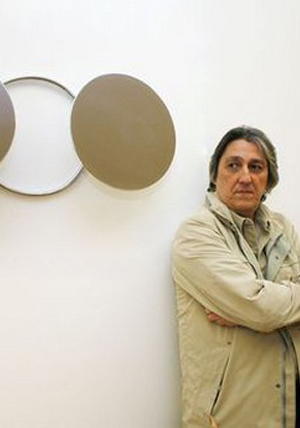|
Waltercio Caldas Júnior (Rio de Janeiro, 1946). Sculptor, draughtsman, graphic artist, stage designer.
At the start of the 1960s, Waltercio Caldas became interested in art and began to visit exhibitions in Rio de Janeiro. He studied with Ivan Serpa (1923 - 1973) at the Museu de Arte Moderna do Rio de Janeiro - MAM/RJ [Museum of Modern Art of Rio de Janeiro] from 1964 onwards. The everyday routine of lectures and visits to the museum`s collection brought him close to modern and contemporary production. In 1967, he began to work as a technical draughtsman and diagrammer for Eletrobrás and took part in his first professional group exhibition at the Gead Gallery. During this period, he drew and made models of improbable architectural projects.
In 1975, he staged his individual exhibition A Natureza dos Jogos [The Nature of Games] at the, Museu de Arte de São Paulo Assis Chateaubriand - Masp [Assis Chateaubriand Museum of Art of São Paulo] consisting of 100 works, including drawings, objects and photographs. Three years later, he executed sculptures such as Convite ao Raciocínio [Invitation to Reason] and Objeto de Aço [Steel Object]. During this period, he created pieces that commented on the works of renowned figures in the history of art, executing the Experiência Mondrian [Mondrian Experience] and Talco sobre Livro Ilustrado de Henri Matisse [Talc on an Illustrated Book by Henri Matisse]. This latter work led to others based on books, such as Aparelhos [Devices], 1979, Manual de Ciência Popular [Popular Science Manual], 1982 andVelázquez, 1996.
From the 1980s onwards, the artist created a greater number of installations. In 1980, he executed Ping Pong, and 0 É Um [Zero is One]. Three years later, he exhibited A Velocidade [Speed] at the 17th Bienal Internacional de São Paulo [São Paulo International Bienal]. At the same time, he worked on a series of sculptures, basically devoting himself to this medium during the second half of the decade. He made videos, drawings and almost invisible interventions in space, although his primary activity is sculpture.
In 1989, his first public sculpture was installed: O Jardim Instantâneo no Parque do Carmo [The Instant Garden in the Parque do Carmo], in São Paulo, producing another open-air piece five years later: Omkring, in Norway. In 1996, he executed the monument Escultura para o Rio [Sculpture for Rio], in the centre of Rio de Janeiro, in which a synthesis of his work is apparent: the conceptual subtlety that has always characterized it, allied to a capacity for mobilizing a public space.
Representing Brazil at the 47th Venice Biennale in 1997, he presented the Venice series in the Brazilian pavilion. He also participated in the Biennial of Visual Arts of Mercosul, Porto Alegre, with the installation "place for a soft stone", exposed earlier in the side event to the ECO92 at MAM, Rio de Janeiro .
In 2007 Caldas participated in the 52nd Venice Biennale - "Pensa con i sensi, senti con la mente" - exposing the work Half Mirror Sharp , in the Pavilion Italy, the invitation for him to participate was from the chief curator of the biennial, Robert Storr.
In 2011 Caldas participated in the Biennial "Entre abierto", Cuenca, Ecuador, in 2011, from which it receives the prize with Parábolas de superfície and the collective "Art Unlimited - what is world . What is not" Art/42/Basel, Switzerland.
|
|

Works:
|
